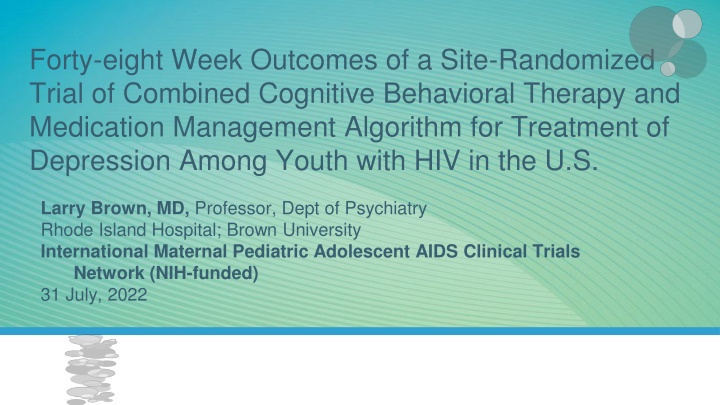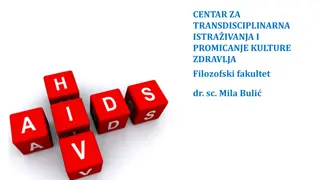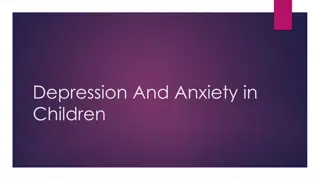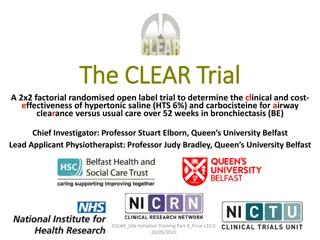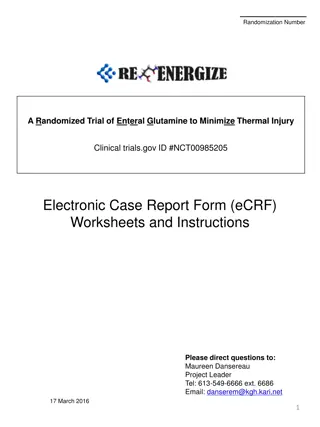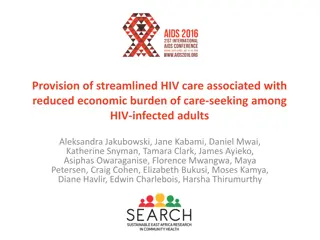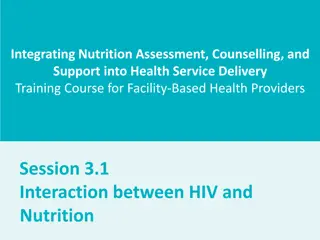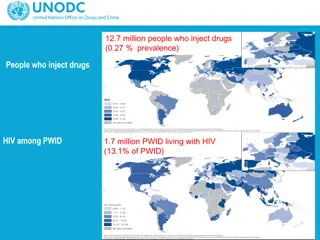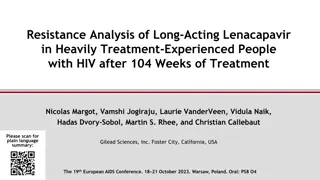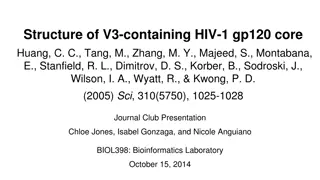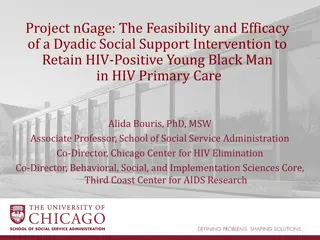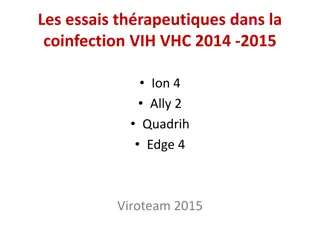Forty-eight-Week Outcomes of a Site-Randomized Trial for Depression Among Youth with HIV
This study explores the outcomes of a site-randomized trial utilizing a combined cognitive behavioral therapy and medication management algorithm for treating depression among youth with HIV in the U.S. The team involved includes medical officers, data managers, statisticians, clinical trial specialists, and participating sites across the country. The study background emphasizes the prevalence of depression in youth with HIV and the efficacy of combination treatment. The adaptation of COMB-R for easier dissemination and training, with a focus on viral suppression and demographic characteristics, is also highlighted.
Download Presentation

Please find below an Image/Link to download the presentation.
The content on the website is provided AS IS for your information and personal use only. It may not be sold, licensed, or shared on other websites without obtaining consent from the author.If you encounter any issues during the download, it is possible that the publisher has removed the file from their server.
You are allowed to download the files provided on this website for personal or commercial use, subject to the condition that they are used lawfully. All files are the property of their respective owners.
The content on the website is provided AS IS for your information and personal use only. It may not be sold, licensed, or shared on other websites without obtaining consent from the author.
E N D
Presentation Transcript
Forty-eight Week Outcomes of a Site-Randomized Trial of Combined Cognitive Behavioral Therapy and Medication Management Algorithm for Treatment of Depression Among Youth with HIV in the U.S. Larry Brown, MD, Professor, Dept of Psychiatry Rhode Island Hospital; Brown University International Maternal Pediatric Adolescent AIDS Clinical Trials Network (NIH-funded) 31 July, 2022
Protocol Team (abbreviated list) Medication Algorithm: Graham Emslie, MD CBT Supervision: Betsy Kennard, PhD NIH Medical Officers: Ellen Townley, MSN, FNP; Adeola Adeyeye, MD, MPA; Sonia Lee, PhD; Susannah Allison, PhD Data Manager: Chelsea Krotje, MPH Statisticians: Miriam Chernoff, PhD; David Shapiro, PhD; Kristin Baltrusaitis, PhD Statistical Programmer: Shirley Traite, MSW Clinical Trials Specialists: Kate Lypen, MPH; Sarah Buisson, MSW, MPH 2
Participating Sites 3 CRS 5114, Bronx-Lebanon Hospital Center CRS 5055, Children s Diagnostic and Treatment Center CRS 5030, Emory University School of Medicine CRS 5052, The University of Colorado CRS 6501, St Jude Children s Research Hospital CRS 5040, Stony Brook University Medical Center CRS 5013, Jacobi Medical Center Bronx CRS 5048, The University of Southern California LA CRS 3801, Texas Children s Hospital CRS 5092, Johns Hopkins University School of Medicine CRS 5083, Rush University Medical Center CRS 5112, David Geffen School of Medicine at UCLA CRS 4601, UCSD
Study Background & Rationale 4 Depression is common among youth with HIV (YWH) and is associated with increased morbidity and mortality. Medication algorithms and cognitive behavioral therapy (CBT) are effective Combination treatment (COMB) is a collaborative, stepped care approach with use of standard measures to guide care Efficacy of COMB for treatment of depression in YWH demonstrated in smaller trial
Study Background & Rationale 5 COMB-R was adapted for easy dissemination training and supervision reduced, and all online, videotaped A larger sample for greater power to detect differences: Viral suppression Demographic characteristics: gender, route of infection (APA) APA. Practice Guideline for the Treatment of Patients with Major Depressive Disorder, Third Edition. 2010. Kennard, B., Brown, L., Hawkins, L., Risi, A., Radcliffe, J., Emslie, G., the Adolescent Trials Network for HIV/AIDS Interventions, S. (2014). Development and Implementation of Health and Wellness CBT for Individuals with Depression and HIV. Cognitive and Behavioral Practice, 21(2), 237 246. http://doi.org/10.1016/j.cbpra.2013.07.003
Study Objectives 6 Primary Objectives - To evaluate whether: Is COMB-R is associated with improved depression outcomes at 24 weeks, compared to Enhanced Standard Care (ESC) COMB-R is associated with improved biological measures of health over 24 weeks (CD4 and HIV RNA) compared to ESC
Study Objectives (Cont.) 7 Secondary Objectives - Examine: Maintenance of depression impact at 48 weeks Impact on viral suppression rates Safety data - psychological hospitalizations and suicide attempts
Study Design 8 Study Population: Youth with HIV diagnosed with nonpsychotic depression (structured clinician rating) Sample Size: 13 U.S. sites were randomized to COMB-R or control, to enroll 156 participants Enhanced Standard of Care: Online training in depression treatment. All sites provided access to therapists and antidepressant medication.
Sample Characteristics at Entry (n= 156) 9 QIDS-C severe ( 16) On antidepressants RNA, 0-40 copies 46% 22% 58% Age (mean, s.d.) Male Race/ethnicity Black, non-Hispanic Hispanic (any race) Route of HIV acquisition Perinatal Behavioral 21.4 (2.8) 47% 57% 33% 53% 47%
Health and Wellness CBT Content Tailored for relevance: stigma, trauma, medical care 24 weeks 10 Treatment Stage Frequency Month Motivation to engage; psychoeducation Weekly 1 Reduce symptoms with core skills; identify strengths Wellness skills relapse prevention Weekly 2 Every other week Monthly 3, 4 Consolidate gains 5, 6
Medication Algorithm Framework, not restrictive, not a specific medication Strategy based on measured care/patient response 11 Stage Treatment Medication Options Stage 0 No medication N/A Stage 1 SSRI Mono Therapy Increase dose or augment partial responses (e.g. lithium, bupropion) Stage 2 2ndSSRI Increase dose or augment partial resp. Stage 3 Non-SSRI Increase dose or augment partial resp. Stage 4 Combination Treatment Two antidepressants or antidepressant plus lithium
12 Results: Depression over 48 weeks
QIDS-SR Over 48 Weeks 13 18 16 ESC COMB-R 14 Difference between ESC and COMB-R sites in QIDS-SR: 12 10 Week 24, [-3.9, (CI =-6.8, -0.9), p = 0.01] Week 36, p = 0.05 8 6 4 2 0 Week 0 Week 12 Week 24 Week 36 Week 48
QIDS-SR Response over 48 Weeks 14 Difference between ESC and COMB-R sites in response (>50% reduction in QIDS-SR): Week 12, p = 0.06 Week 24, p < 0.001 [44 (CI =23.1, 65.5), p < 0.001] Week 36, p = 0.02 Week 48 p = 0.05 70.00% 60.00% 50.00% 40.00% 30.00% 20.00% 10.00% 0.00% Week 12 Week 24 ESC Week 36 Week 48 COMB-R
QIDS-SR Remission over 48 Weeks 15 60.00% 50.00% Difference between ESC and COMB-R sites in remission (QIDS-SR 5): 40.00% 30.00% Week 24, [31 (CI = 8.9, 52.9), p = 0.01] Week 36, p = 0.05 20.00% 10.00% 0.00% Week 12 Week 24 Week 36 Week 48 ESC COMB-R
16 Results: Viral Load / CD4 Over 48 Weeks
Viral Suppression and CD4 <200 over 48 weeks (COMB-R vs. ESC) Viral Suppression 17 CD4 < 200 100.00% 50.00% 80.00% 40.00% 60.00% 30.00% 40.00% 20.00% 20.00% 10.00% 0.00% 0.00% Week 0 Week 24 Week 48 Week 0 Week 24 Week 48 ESC COMB-R ESC COMB-R The site mean viral load, % viral suppression, CD4 level, and % CD4 < 200 were not significantly different between arms at any week
Safety Results Over 48 Weeks 18 The proportions of participants with a psychiatric hospitalization or suicide attempt were not significantly different between arms at any point (7% vs. 4% by week 48). Note: non-parametric sensitivity analyses largely confirmed all findings being presented.
19 Results: Medication use over 48 weeks
Antidepressant and SSRI use over 48 Weeks 20 Antidepressant use SSRI use 50% 50% 40% 40% 30% 30% 20% 20% 10% 10% 0% 0% Week 0 Week 24 Week 48 Week 0 Week 24 Week 48 ESC COMB-R ESC COMB-R Difference between sites in SSRI use: Week 24, p = 0.02 Difference between sites in antidepressant use: Week 24, p = 0.06
Conclusions Combination of medication algorithm and tailored CBT using measured care for 24 weeks resulted in: Improved depression at 24 weeks with effects to 36 & 48 Greater use of SSRIs, but therapy visits not increased No impact on viral load contrary to hypotheses o ESC received excellent, supportive care o Depression is just one of many factors influencing adherence o Adherence skills mainly in early COMB-R sessions 21
22 THANKS! To IMPAACT, Staff, Participants Any questions? You can find me at Larry_Brown@brown. edu
